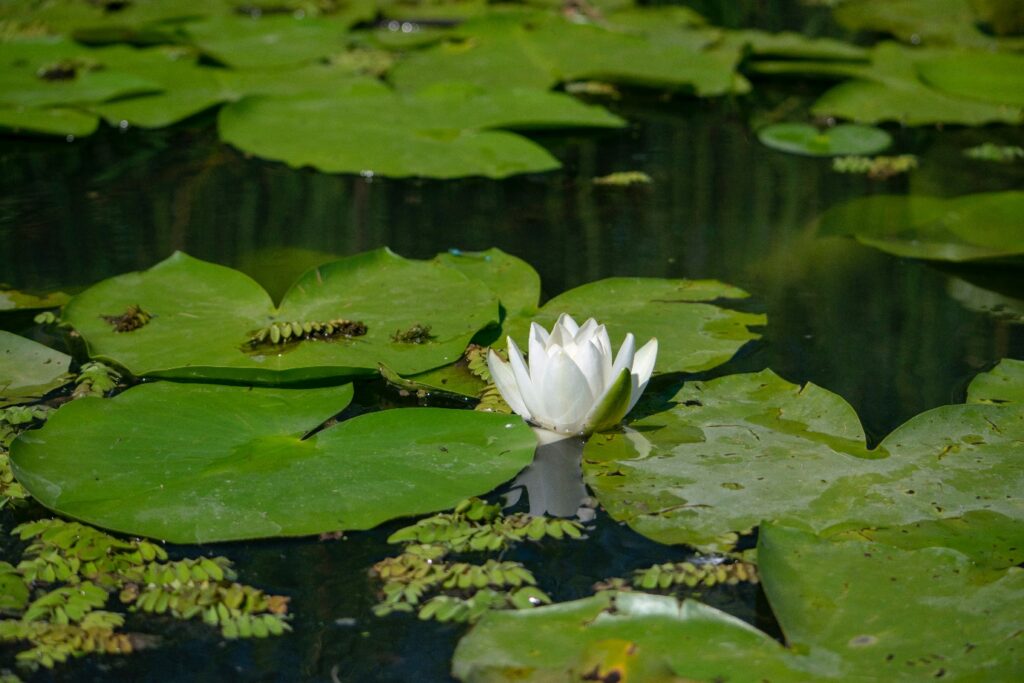
The 10 best Pond Plants to Combat Algae in the UK
Algae growth can be a common issue in UK ponds and water features. To combat algae and maintain a healthy aquatic environment, consider adding the following plants to your pond or water garden. These plants help control algae by competing for nutrients and providing shade, which limits sunlight penetration and discourages algae growth:
- Water Lilies (Nymphaea spp.): Water lilies are excellent for providing shade and reducing sunlight in the water, which inhibits algae growth. They also help maintain water quality.
- Marginal Plants: These plants are typically planted at the pond’s edge, where their roots can help filter nutrients from the water. Some good options include:
- Marsh Marigold (Caltha palustris): Adds color and filters nutrients.
- Yellow Flag Iris (Iris pseudacorus): Tall and robust, it helps reduce nutrient levels.
- Pickerelweed (Pontederia cordata): Provides cover for fish and filters nutrients.
- Hornwort (Ceratophyllum demersum): An excellent submerged plant that absorbs excess nutrients and provides oxygen, which can inhibit algae growth.
- Waterweed (Elodea canadensis): Similar to hornwort, waterweed is a submerged plant that competes with algae for nutrients.
- Floating Plants: These plants cover the water’s surface, limiting sunlight penetration and providing shade. Consider:
- Water Hyacinth (Eichhornia crassipes): Floats on the water’s surface, absorbing nutrients and blocking sunlight.
- Water Lettuce (Pistia stratiotes): Similar to water hyacinth, it provides shade and nutrient absorption.
- Water Hawthorn (Aponogeton distachyos): This attractive plant produces floating leaves that shade the water and reduce light penetration.
- Oxygenators: These submerged plants oxygenate the water and compete with algae for nutrients. Common choices include:
- Anacharis (Elodea densa): Provides oxygen and nutrient competition.
- Water Violet (Hottonia palustris): Adds oxygen and beauty to the pond.
- Cattails (Typha spp.): Tall, emergent plants that absorb nutrients and provide habitat for wildlife.
- Horsetail Rush (Equisetum hyemale): This plant has a dense, vertical growth habit that provides shade and can outcompete algae for nutrients.
- Lemna (Duckweed): A tiny floating plant that forms a dense mat on the water’s surface, blocking sunlight and absorbing nutrients.
Remember that proper pond maintenance, such as removing dead plant material and ensuring a balanced ecosystem with the right mix of plants and fish, is also crucial in preventing algae overgrowth. Additionally, the effectiveness of these plants may vary depending on the specific conditions of your pond or water feature, so it’s essential to monitor and adjust as needed.
0 best plants to combat Algae in the UKAlgae is perhaps the top complaint of any pond owner. It’s the uninvited companion to your pond that will not only deplete your water of oxygen but also keep colorful fish from being seen and healthy.
This green goblin of a plant makes your pond an unremarkable sight, ruining the appearance and health of the pond. In the UK, there’s an elevated problem with Algae-filled ponds that are deprived of their natural beauty. To restore that and keep algae from filling up your pond there are a range of techniques you can use, from shop bought products and filters but as is often the case in life – nature has an answer. A natural, balanced and even beautifying solution to keeping algae at bay is to use the right pond plants.
There you have it. Your guide to the best pond plants to reduce algae in the UK – the key to the health of any pond is diversity, and filling it with a variety of beneficial plants which all contribute In their own way.
These plants will not only help to keep the water clear of algae, they’ll help to attract and support an array of wildlife, and add much revered beauty to your landscape.
Do you have any questions about choosing the right plants for your pond? Talk to us!


